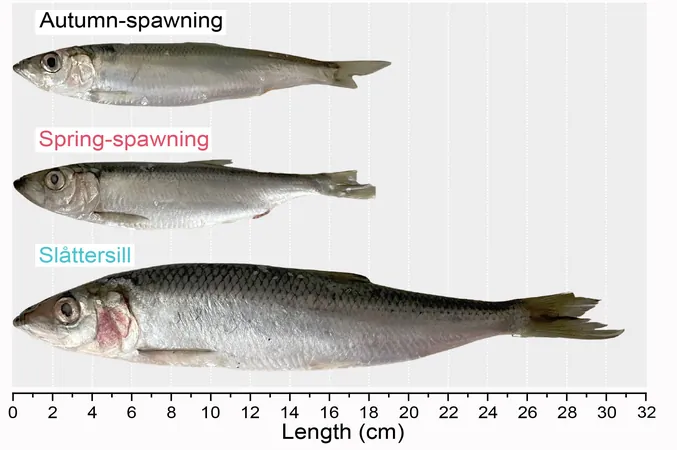
Shocking Discovery: Fish-Eating Herring Evolve in the Baltic Sea!
2024-12-23
Author: Ming
Groundbreaking Study by Uppsala University
A groundbreaking study led by scientists from Uppsala University in Sweden has uncovered the evolution of genetically distinct fish-eating herring in the Baltic Sea, a region that has only been around for approximately 8,000 years since the end of the last glaciation. This discovery, published in *Nature Communications*, highlights the crucial role of both Atlantic and Baltic herring as foundational species in the northern Atlantic and Baltic Sea ecosystems.
Ecological Importance of Herring
Typically known as plankton-eating fish, herring serve as a vital link in the food chain, connecting plankton production with larger predators, including fish, seabirds, marine mammals, and humans. Previous studies indicated that herring display various ecotypes, which adapt genetically to different environmental conditions like climate variations, salinity levels, and spawning times.
Historical Context and Adaptation
The historical context is impressive—Linnaeus, the pioneering figure in taxonomy from the 18th century, classified the Baltic herring as a subspecies of Atlantic herring, specifically adapted to the brackish waters of the Baltic Sea. Notably smaller and leaner than its Atlantic counterpart, the Baltic herring was thought to have a relatively fixed dietary focus.
A Unique Population
However, the current research took a fascinating turn when a local fisherman brought attention to a unique population of larger herring that spawns just before midsummer. "I was intrigued by reports of a specific group of large Baltic herring that consistently spawns in the same region every year, prompting me to investigate their genetic makeup," explains Professor Leif Andersson from Uppsala University.
Remarkable Discoveries
Upon extensive research into their morphology and growth patterns, the scientists made remarkable discoveries. The larger herring displayed notable gill raker damage, a key feature for plankton filtering in standard Baltic herring—suggesting a recent dietary shift towards other fish, likely including small spiny sticklebacks, known for their predation defense mechanisms.
Implications for Human Consumption
Additionally, these robust herring exhibited a higher fat content and lower levels of dioxin, a harmful pollutant found in the Baltic Sea. This combination of traits points towards their efficient flesh quality, making this fish-eating herring an appealing prospect for human consumption.
Whole-Genome Sequencing
The researchers went a step further by conducting whole-genome sequencing on these large herring, along with samples from various regions of the Baltic Sea, revealing the existence of at least two distinct subpopulations of fish-eating herring. One resides north of Stockholm, while the other is found to the south.
Unique Evolutionary Developments
A compelling question arises from these findings: how did fish-eating herring evolve in the Baltic Sea, a phenomenon not observed in the broader Atlantic Ocean? The relatively young age of the Baltic Sea combined with lower salinity levels creates a unique ecological environment that has allowed only a select number of marine species to adapt, paving the way for these astonishing evolutionary developments.
Implications for the Future
This new research sheds light on the dynamic evolution of herring species in the Baltic Sea and poses important implications for both environmental monitoring and fisheries management. With the rapid changes in marine ecosystems, understanding such adaptations could be critical for the future of aquatic biodiversity. Stay tuned for more astonishing revelations from the world of underwater science!





 Brasil (PT)
Brasil (PT)
 Canada (EN)
Canada (EN)
 Chile (ES)
Chile (ES)
 España (ES)
España (ES)
 France (FR)
France (FR)
 Hong Kong (EN)
Hong Kong (EN)
 Italia (IT)
Italia (IT)
 日本 (JA)
日本 (JA)
 Magyarország (HU)
Magyarország (HU)
 Norge (NO)
Norge (NO)
 Polska (PL)
Polska (PL)
 Schweiz (DE)
Schweiz (DE)
 Singapore (EN)
Singapore (EN)
 Sverige (SV)
Sverige (SV)
 Suomi (FI)
Suomi (FI)
 Türkiye (TR)
Türkiye (TR)